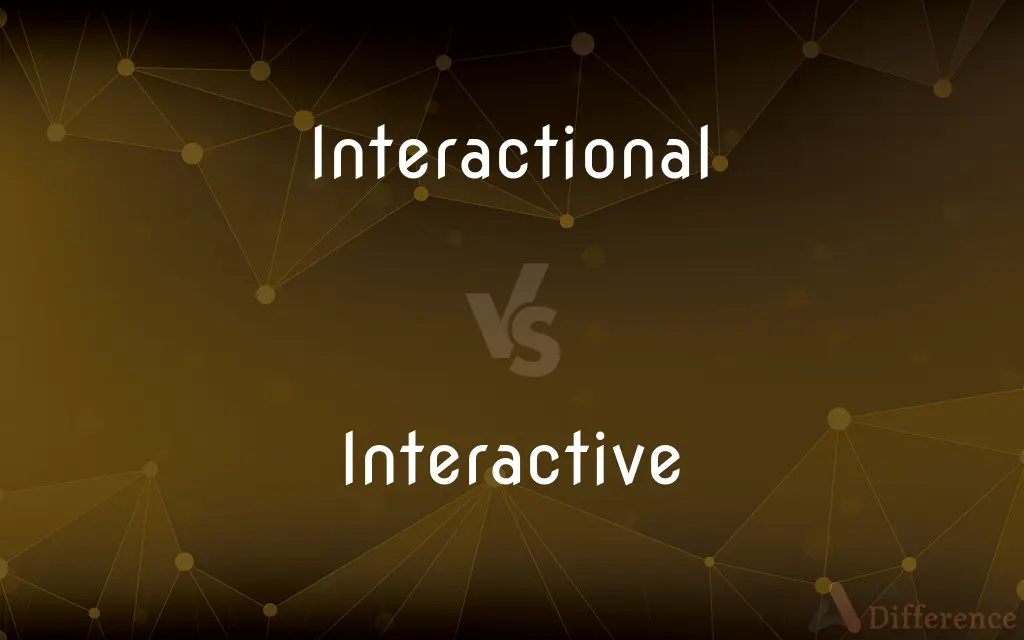Interactional vs. Interactive — What's the Difference?
By Fiza Rafique & Urooj Arif — Updated on March 30, 2024
Interactional dynamics focus on social exchanges and communication patterns, while interactive refers to the reciprocal action or influence between people and systems, particularly in technology.

Difference Between Interactional and Interactive
Table of Contents
ADVERTISEMENT
Key Differences
Interactional communication emphasizes the social and linguistic exchanges between individuals, focusing on how these interactions shape relationships and understanding. It's concerned with the nuances of verbal and non-verbal communication, including tone, context, and body language. On the other hand, interactive often describes systems, particularly in technology, designed for reciprocal action where human input directly influences outcomes, such as user interfaces in software or digital platforms.
Interactional dynamics delve into the complexities of human relationships, exploring how individuals influence and are influenced by their social environments. This perspective is crucial in fields like sociology, psychology, and communication studies, where understanding human behavior in social contexts is key. Interactive, however, tends to highlight the functionality and design of systems that engage users, ensuring that interactions are efficient, engaging, and productive.
In interactional exchanges, the focus is on the flow of communication and the roles individuals play within a conversation or social setting. These dynamics can be cooperative or competitive, with the quality of the interaction influencing social bonds and perceptions. Conversely, in interactive systems, the emphasis is on the design and user experience, aiming to create intuitive and responsive environments that adapt to user inputs, enhancing usability and satisfaction.
The interactional approach is deeply rooted in the study of languages, culture, and interpersonal relationships, providing insights into how communication constructs and conveys meaning. It examines the structures and patterns of interactions, such as turn-taking in conversations and the use of language in different social contexts. Interactive, by comparison, is a concept widely applied in the digital age, referring to technologies and systems that respond to user actions, from websites and applications to smart devices and virtual reality.
Despite their differences, both interactional and interactive elements can coexist, especially in digital communication platforms where technology facilitates human interactions. Online forums, social media, and collaboration tools blend interactive technology with interactional dynamics, creating spaces where technology and social exchange converge, highlighting the evolving nature of human communication in the digital era.
ADVERTISEMENT
Comparison Chart
Focus
Social exchanges and communication patterns
Reciprocal action/influence between people and systems
Key Fields
Sociology, psychology, communication studies
Technology, computer science, digital design
Emphasis
Verbal and non-verbal communication, social dynamics
User-system interaction, usability, user experience
Applications
Interpersonal relationships, language studies
Digital platforms, software, user interfaces
Outcome
Understanding human behavior in social contexts
Creating efficient and engaging systems that respond to user inputs
Compare with Definitions
Interactional
Focused on communication patterns and behaviors.
The study explores the interactional effects of non-verbal cues.
Interactive
Pertaining to systems that respond to user inputs.
The new website is highly interactive and user-friendly.
Interactional
Analyzes the structure and function of social interactions.
Her research on interactional justice impacts organizational culture.
Interactive
Designed for engagement and direct involvement.
They launched an interactive campaign to increase customer interaction.
Interactional
Relating to social exchanges between individuals.
Their interactional style during meetings improved team dynamics.
Interactive
Focused on reciprocal action between user and system.
The interactive exhibit allows visitors to explore art in novel ways.
Interactional
Concerned with the dynamics of human relationships.
Interactional sociology examines how societal norms influence conversations.
Interactive
Emphasizes user experience in technology design.
Good interactive design is essential for app usability.
Interactional
Involves the reciprocal influence of individuals in social settings.
Interactional language teaching emphasizes real-life communication.
Interactive
Involving communication between people and technology.
Interactive learning tools have transformed educational methodologies.
Interactional
Of, pertaining to, or featuring interaction.
Interactive
Acting or capable of acting on each other.
Interactional
Capable of acting on or influencing each other
Interactive
(Computers) Of or relating to a program that responds to user activity.
Interactive
Of, relating to, or being a form of television entertainment in which the signal activates electronic apparatus in the viewer's home or the viewer uses the apparatus to affect events on the screen, or both.
Interactive
Interacting with or communicating with and reacting to each other; influencing or having an effect on each other; acting or capable of acting on each other or with the other.
Interactive teaching methods
Two interactive systems
Interactive
(computer science) Responding to the user.
Interactive user interface
Interactive
A feature (as in a museum) that can be interacted with.
Interactive
Used especially of drugs or muscles that work together so the total effect is greater than the sum of the two (or more)
Interactive
Capable of acting on or influencing each other
Common Curiosities
Is interactional communication limited to verbal exchanges?
No, it includes both verbal and non-verbal cues, such as gestures, facial expressions, and body language.
Can interactional and interactive elements coexist in a platform?
Yes, many digital platforms integrate both, facilitating human interactions through interactive technology.
How do interactive systems improve user experience?
By designing intuitive interfaces that respond to user actions, making technology more accessible and engaging.
Are interactive technologies always digital?
While commonly associated with digital technology, interactive systems can also include physical interactions, like interactive exhibits in museums.
How does interactive design affect learning?
Interactive design can enhance learning by making educational content more engaging, accessible, and tailored to individual learners.
Can interactional studies apply to online communication?
Absolutely, as they explore how digital environments affect communication patterns and social dynamics.
What role does user feedback play in interactive systems?
It's crucial for refining and improving the design and functionality of interactive systems, ensuring they meet user needs.
How do interactional dynamics influence group behavior?
They can shape the cohesion, efficiency, and overall dynamics of a group by affecting communication patterns and relationships.
What's the importance of non-verbal cues in interactional communication?
Non-verbal cues play a significant role in conveying emotions, intentions, and responses, often complementing or contradicting verbal messages.
Can interactional analysis be used in conflict resolution?
Yes, understanding the interactional patterns in conflicts can help identify underlying issues and improve communication strategies for resolution.
Share Your Discovery

Previous Comparison
Segregation vs. Discrimination
Next Comparison
Plant vs. SaplingAuthor Spotlight
Written by
Fiza RafiqueFiza Rafique is a skilled content writer at AskDifference.com, where she meticulously refines and enhances written pieces. Drawing from her vast editorial expertise, Fiza ensures clarity, accuracy, and precision in every article. Passionate about language, she continually seeks to elevate the quality of content for readers worldwide.
Co-written by
Urooj ArifUrooj is a skilled content writer at Ask Difference, known for her exceptional ability to simplify complex topics into engaging and informative content. With a passion for research and a flair for clear, concise writing, she consistently delivers articles that resonate with our diverse audience.















































